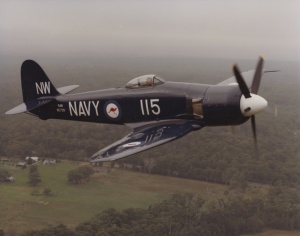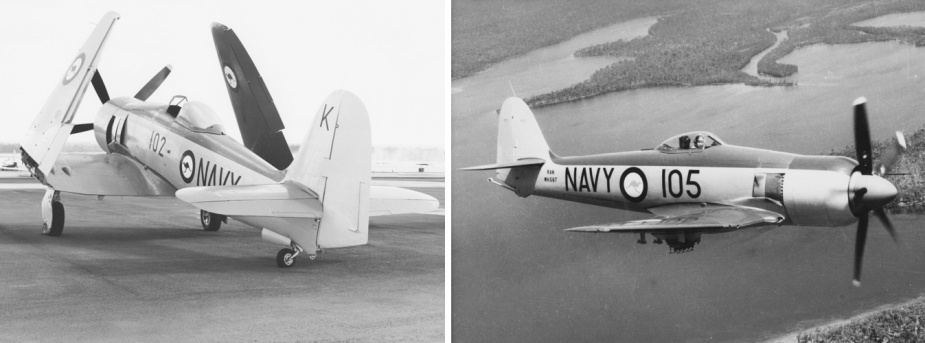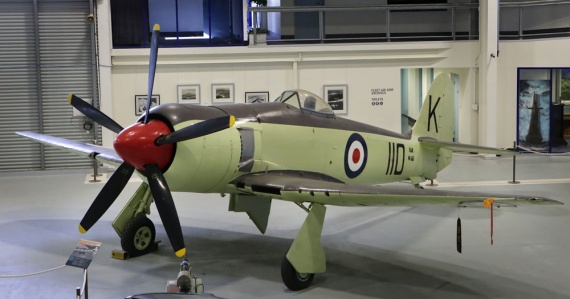Hawker Sea Fury Mark 11
| Type |
Carrier-borne fighter bomber |
|---|---|
| Manufacturer |
Hawker Aircraft Ltd, Kinston-on-Thames, Surrey, UK |
| Number Ordered |
101 |
| First Delivered |
May 1949 |
| Last Delivered |
1953 |
| Length |
34 feet 8 inches |
| Height |
15 feet 10 inches |
| Weights | 9240 lbs |
| Dimensions | Wing span: 38 feet 5 inches |
| Speed | 435 mph |
| Range |
680 miles at 30,000 feet |
| Crew |
1 |
| Engines | One 2480 hp Bristol Centaurus 18 cylinder radial |
| Performance |
|
| Armament |
Guns: 4 x 20mm, Bombs: 8 x 60 lb rockets or 2 x 1000 lb bombs |
| Ships embarked in |
The Sea Fury was a British fighter aircraft designed and manufactured by Hawker Aircraft Limited and was one of the fastest production single reciprocating engine aircraft built. Development began in 1943, for the Royal Air Force (RAF), with the aircraft initially named the Fury and based on the then in-service Typhoon and Tempest fighters also built by Hawker. At the end of the war the RAF cancelled their order; however, the Royal Navy (RN) considered the aircraft as a suitable replacement for its now obsolete carrier borne fighters. Development of the now named Sea Fury proceeded, and the first production model flew in September 1946 and by early 1947 the aircraft were in operational service with the RN Fleet Air Arm.
The Sea Fury was powered by the Bristol Centaurus engine, which drove a five-bladed propeller. Many of the engine's subsystems, such as the fully automated cooling system, cockpit gauges, and fuel booster pump were electrical, powered by an engine-driven generator supplemented by two independent batteries. The hydraulic system operated the retractable undercarriage, tail hook, and flaps. Fuel was stored in a total of five self-sealing fuel tanks, two within the fuselage directly in front of the cockpit and three housed within the wings.
The Royal Australian Navy Fleet Air Arm was formed in 1948 with its first aircraft carrier HMAS Sydney commissioned in the United Kingdom in December of that year. The first 25 RAN Sea Fury’s were embarked in Sydney in April 1949 and allocated to 805 Squadron. The carrier sailed for Australia in mid-April 1949 arriving in Sydney in late May. Further batches of Sea Fury’s were delivered to the RAN in December 1950, October 1951, March 1952, January 1953 and January 1954. Although the Sea Fury had been originally developed purely as an air superiority fighter, its solid construction and the payload capabilities of the airframe made it well suited for ground attack duties. The aircraft had four wing-mounted 20 mm Hispano V cannon and could also carry up to 16 rocket projectiles, or a combination of 500 lb or 1000 lb bombs.
A second Sea Fury Squadron (808 Squadron) was formed in April 1950 and conducted training at sea in Sydney or from the Naval Air Station at Nowra. In mid-1951 the RAN was advised that Sydney would deploy to Korean waters to support United Nations operations in the Korean War. 805 and 808 Squadrons were embarked in Sydney along with 817 Squadron operating the Fairey Firefly fighter-bombers and sailed from Australia in late August 1951. The RAN aircraft flew their first sortie on 4 October 1951 and over the next four months 2366 sorties were flown from the carrier. A total of eight Sea Fury’s were lost, or damaged beyond repair, on operations in Korea before the last sortie was flown on 25 January 1952.
Three aircrew, all from 805 Squadron, were killed flying Sea Fury aircraft in Korea. The first was Lieutenant Keith Clarkson, DFM, RAN a former WWII RAAF fighter pilot who was shot down on 5 November 1951 while strafing North Korean ground targets. On 7 December 1951 Lieutenant Richard Sinclair, RAN was killed while bailing out of his flak damaged aircraft; he hit the tailplane and was killed instantly and his body later recovered and buried at sea from Sydney with full naval honours. The last to die was Sub-Lieutenant Ronald Coleman, RAN whose Sea Fury disappeared while on a combat air patrol over the Yellow Sea on 2 January 1952. Both Clarkson and Sinclair are still formally listed as ‘Missing in Action’ by the RAN. 808 Squadron was much luckier with only one aircraft shot down by the enemy and its pilot rescued by a US Navy helicopter.
Following Sydney’s return from Korea the Sea Fury squadrons returned to Nowra for recuperation and then commenced working up again for possible return to Korea. The aircraft carrier HMS Vengeance was loaned to the RAN in November 1952, becoming HMAS Vengeance, and a third Sea Fury Squadron (850 Squadron) was formed in January 1953. None of the Sea Fury Squadrons deployed to the United Kingdom, with Sydney, during the 1953 cruise for the coronation of Queen Elizabeth II.
Following the signing of the Armistice, on 27 July 1953, hostilities ceased on the Korean Peninsula but post-Armistice maritime patrols were required to ensure that peace was maintained. Sydney deployed to Korean waters again with Sea Fury’s; 805 and 850 Squadrons were embarked for the deployment in Korean waters from November 1953 until June 1954. Although hostilities had ceased flying from a carrier was still a dangerous activity. Sub-Lieutenant Michael Beardsall, RN (850 Squadron) was killed when his Sea Fury crashed into the sea on 29 December 1953; his body was not recovered. Sub-Lieutenant John McClinton, RN (805 Squadron) died on 15 January 1954 after walking into the spinning propeller of an aircraft.
Meanwhile 808 Squadron Sea Furies served in Vengeance from September 1953 until the Squadron was decommissioned on 5 October 1954. 850 Squadron had already been decommissioned at Nowra in August 1954. The Sea Fury’s began to be phased out of service in 1955-56 as the jet engine De Havilland Sea Venom began to enter RAN service. 805 Squadron was decommissioned on 26 March 1958; the Sea Fury’s making a final farewell flight over Sydney Harbour on 18 March.
The remaining Sea Fury aircraft were sold during the period 1959 – 1963 and a few were used for fire-fighting training at Nowra in the early 1960’s. 724 and 725 Squadrons operated some Sea Fury’s as training aircraft with the last recorded flight in October 1962.





